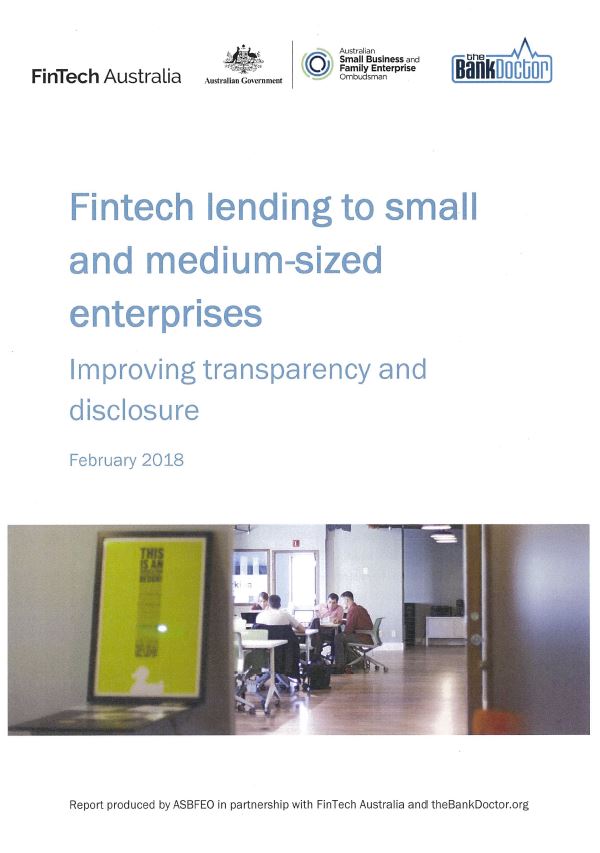Today Kate Carnell, the Australian Small Business & Family Enterprise Ombudsman (ASBFEO), Danielle Szetho, CEO of the industry association Fintech Australia (FA) and theBankDoctor.org published a detailed report on improving transparency in the fintech business lending sector.
 This is an excellent piece of work, and will reinforce the legitimacy of SME lending from Fintechs, which from our analysis is growing fast, as the major banks continue to fail in their support of the SME sector in Australia.
This is an excellent piece of work, and will reinforce the legitimacy of SME lending from Fintechs, which from our analysis is growing fast, as the major banks continue to fail in their support of the SME sector in Australia.
The key resolutions are:
- FA and its industry working group will consult with stakeholders to develop a Code of Conduct by June 2018 to cover unsecured business loans by fintech balance sheet lenders.
- FA and its industry working group will work with the ASBFEO to ensure they comply with the Unfair Contract Terms legislation.
- by June 2018 FA and the industry working group would agree on a common set of plain English key terms and conditions to be highlighted in a summary page in all loan agreements.
- ASBFEO will facilitate a discussion between fintechs and the Australian Financial Complaints Authority to explore alternative external dispute resolution services in early 2018.
- ASBFEO will work with the FA to ensure they comply with the Unfair Contract Terms legislation.
- theBankDoctor.org will write an education piece, in conjunction with ASBFEO, specifically for SMEs to help them understand the “ins and outs” of borrowing from a fintech.
I asked TheBankDoctor Neil Slonim what was the most significant outcome from the report:
“The biggest challenge now is for the the fintech lenders to actually work together to meet the commitments agreed upon. It will not be an easy task given the large number of participants (around 30) and the fact that their business models can be quite different. Compounding this is the fact that not all lenders are members of the industry association Fintech Australia so there is only so much FA can do. The final sentence in Kate Carnell’s foreword is telling … I will keenly monitor progress against the resolutions in this report”
Neil also provided some background on the initiative:
This collaborative and ground breaking project has been twelve months in the making and represents a line in the sand on industry self regulation which is needed to ensure this rapidly emerging sector fulfils its potential of becoming a significant source of funding for Australian SMEs.
I started researching fintech business lending some three years ago when I recognized these lenders could help the large number of businesses unable to access bank funding. These SMEs typically want to borrow less that $250,000 and lack property which could be offered as security.
Through the use of technology, fintech business lenders can make a real difference to small businesses but access to funding is one thing, understanding all the terms and conditions is another. It is almost impossible to make apples with apples comparisons between the wide range of offerings, especially in relation to the total cost of borrowing where annualised rates of interest can range from 14% pa to 80% pa. I figured that if someone like me with 30 years experience in business finance struggled with this, what hope do time poor and often financially unsophisticated SME have? So I decided to conduct a survey of fintech business lenders to help SMEs answer three simple questions:
1. Is this the right product for my needs?
2. Do I know exactly what it is going to cost?
3. Do I know that I can’t get a better deal elsewhere?But as an unauthorized, unelected and unpaid SME advocate, my capacity to get lenders to participate in the survey was limited and then any findings would be unenforceable anyway. That’s when I reached out to Kate Carnell and Danielle Szetho who willingly agreed to conduct this joint project.
Fintech Australia brings its authority and membership base although not all fintech lenders are members of FA and lenders, whether members of Fintech Australia or not, operate different business models and have diverse views. One of the most telling responses in the survey was that lenders were evenly divided on the question of the adequacy of the current level of industry transparency and disclosure. This provides an insight into the challenges of self regulation.
I applaud the lenders who have embraced this opportunity to drive self regulation. With initiatives like the Glossary of Terms, which is published as an appendix to the report, fintech lenders are now setting standards for other non-bank lenders to follow.
Kate Carnell and her team have been constructive and collaborative in helping fintech lenders reach agreement on areas in which more can be done to improve transparency and disclosure. As the banks have learned, Ms Carnell is a no nonsense champion of the small business sector and she can be relied upon to follow up on her commitment to “keenly monitor progress against the resolutions in this report” .
I am pleased our work has brought the issue of transparency and disclosure in fintech business lending clearly into the public arena and look forward to continuing to work with all parties to enable these lenders to become significant, transparent and trusted alternative sources of debt finance for Australian SMEs.
